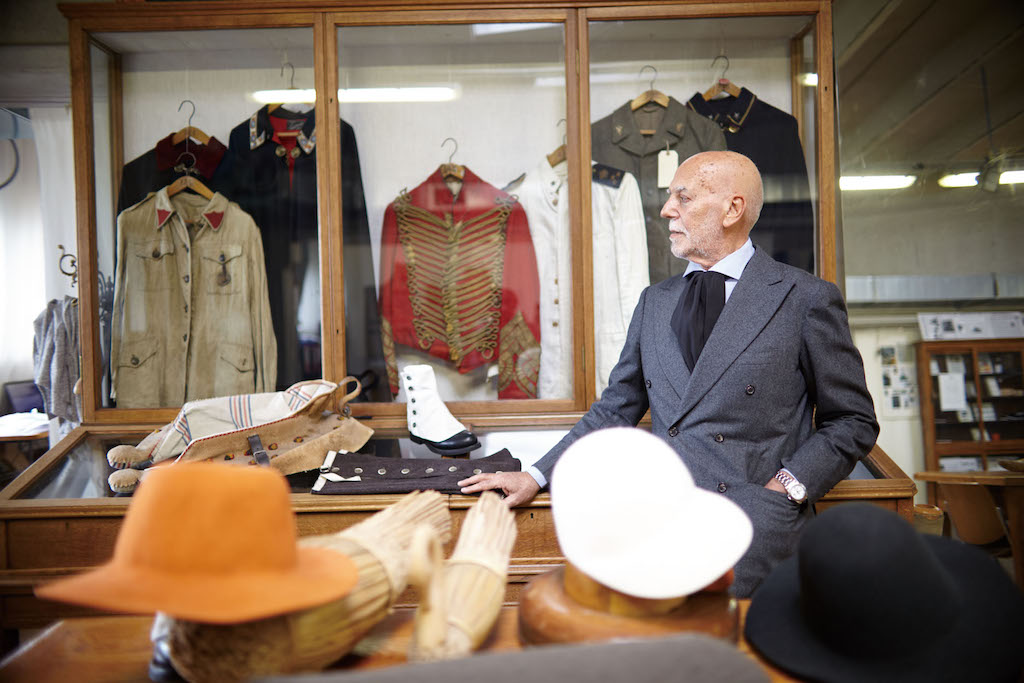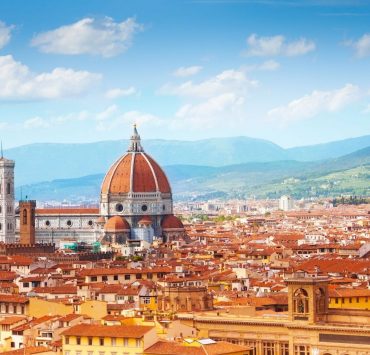We talked to Sandro Zara, one of the last remaining true gentlemen. Born in 1941, Zara’s life has been defined by style, a passion that has become a profession and an infinite love for the beautiful and well-made tabarro cloak, a symbol of Italian style.
The Tabarro: Venice’s legendary garment and it's maker
In his Tabarrificio Veneto he produces the real tabarro, a unique cloak with an ancient history that possesses endless charm. Much like his garment, Zara’s life and his road to mastery are truly fascinating.

How did this love for the tabarro emerge?
The famous wool thread, as I like to call it, which I have been carrying around all my life, started in my childhood, here in Mirano where I had one of the few tailors living under my house, immediately after the war. I saw how he dipped and decated the fabrics and then dried and ironed them. It has always fascinated me how Venice—the largest producer of cloths between 1500 and 1600—had the fabrics dyed with natural pigments, which the Serenissima itself procured around the world through its merchant traffic.
I started travelling when I was very young and went to work with Alfonso Coin, founder of the famous Italian department store COIN, in his company. I was given responsibility over the drapery: the set of fabrics needed for a man to “build” clothes. He taught me to distinguish between fabrics. Knowing how to touch wool and to smell it to understand whether it was regenerated because, at the time, oils were used for this practice with an unpleasant odour that didn’t dissipate. Having had a master like him allowed me to work in a prestigious wool mill and learn the techniques of weaving and finishing. Fabric is something that either bewitches or bores you.
Then I was lucky enough to have the means to cultivate my passion whilst working at Levi’s in early 1972 when they didn't even have a representative office. I remember they interviewed me at the American Consulate in Milan, and from there, I became their agent. And I made my fortune.
The meeting that marked a turning point in my life was the one with Giorgio Zava Cini, a well-known wool manufacturer at the time, of the Cini family (a brand, which I now own). He was also a real wizard of fabrics, and as a great gesture of friendship, he bestowed me with their historical archive, which I continue to preserve.
I went to visit museums and looked for traces of the tabarro cloak, but they only displayed how the doge and the dogaressa dressed and not the clothing of ordinary people. And so, I put up a sign in front of my shop with the words: “I will give a new windbreaker to all those who bring me an old cloak.” After a week I had to take the sign down because I received so many! Even though most of them were unusable, I still had a lot of samples that revealed the details of this incredible garment.
“Tabarro. Out of fashion from birth, but in style throughout history.” – Feliciano Benvenuti (Italian jurist)
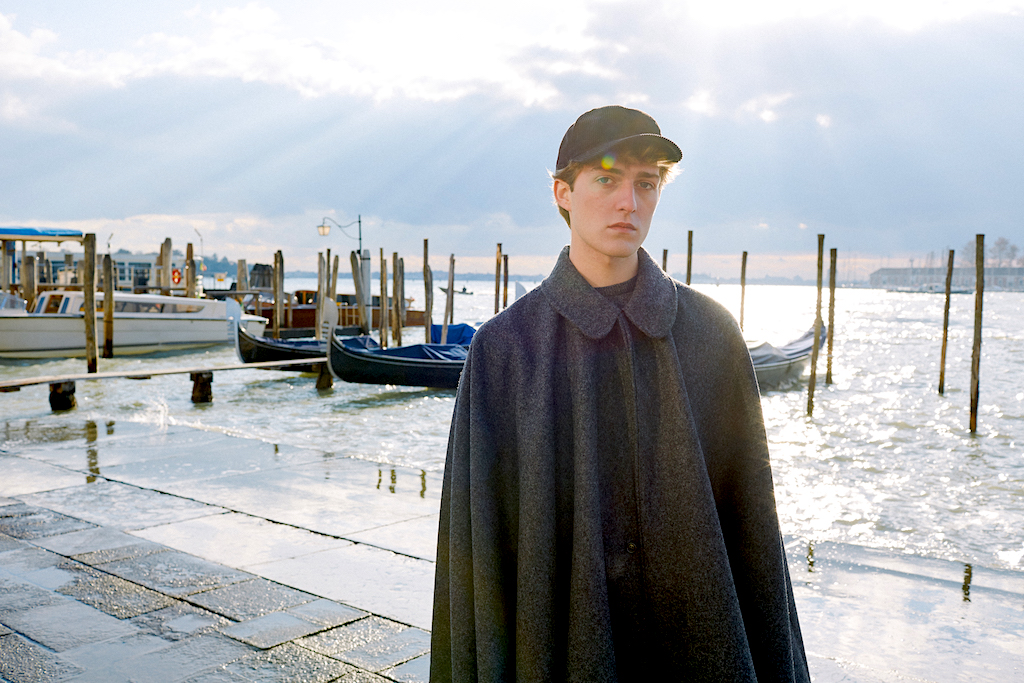
How long does it take to make the cloak? How important are the materials?
In our workshop, where expert hands are at work, the cutting, sewing and ironing only take a few hours. However, setting the garment, especially if you use the more demanding fabrics from Loro Piana, requires more time.
For the long model, which is a full wheel, you need six meters of fabric. The fabric is decisive. Fabrics that weighed between 700 and 800 grams per linear meter were used back then, due to the colder temperatures at the time. Nowadays, I don't go below 600 grams per linear meter. I tolerate 595, and 590, but nothing below this weight, and otherwise it’s no longer a cloak. In the past, having six meters of wheel was considered a sign of prestige. It was equivalent to having today’s luxury car. The nobles wore it as long as possible to show off. On the other hand, the half-wheel model was more practical, for those who worked or rode a bicycle, for example.
How does one wear a tabarro cloak?
It has to be sewn well to fit perfectly on the shoulders: it shouldn’t slip backwards. When you twirl the cloak over your shoulders and position it correctly, it should wrap around you completely. You can sweep one side over your shoulder, with the underside turning over, a movement that comes naturally and doesn’t require a lesson. Our different numbered models adapt to the person who wears them: the long Nobleman and the shorter Brigantino, for example, and for women, the long cloak is certainly more intriguing. But do beware, the cloak has no size! I’ve made cloaks for the greatest opera singers in the world and also for the not-so-tall celebrities.
“Twenty-five years ago, when I sent the first cloaks to America, a journalist wrote, ‘They are the first cloaks to land in the US without an immigrant inside.‘ Now we export them all over the world.” – Sandro Zara
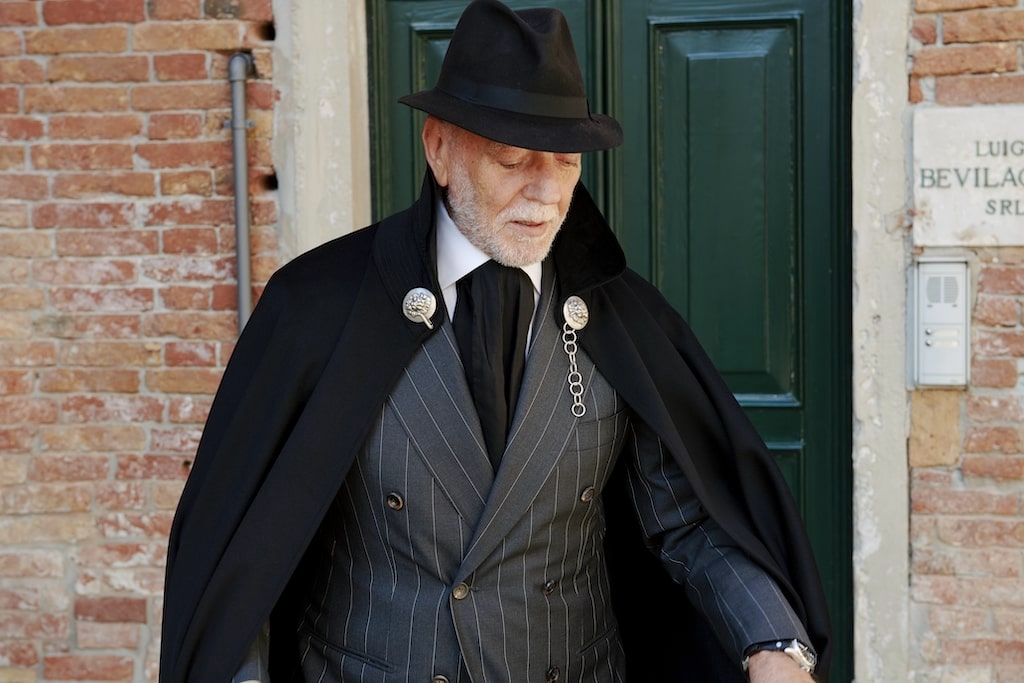
Is the tabarro Venetian by definition or does it also have a place in the modern metropolis?
Tabarri adapt to any look if worn with style. Trendy Venice was the New York of its time and gondolas and paludamentums (including tabarri) were originally colourful, bedecked with frills and coloured tassels as a distinctive sign and symbol of ostentation by the wealthy. Following one of the most ferocious waves of the pest, the government decided that everything should be black as a sign of mourning. And so, it was, and so it remained: black gondolas and cloaks. A trend that continues today.
The tabarro is born with a fabric that has a weft called double rope with threads that intertwine, which allows the hem to stay put, in other words, a raw cut hem. I wear it with a jacket underneath, and when you wrap it around you, it really warms you up, even on a rainy day. You look great, all covered up, along with suitable shoes and a hat. No wind breaker keeps you warm like a cloak. It’s what I call a ‘nice outfit,’ and it’s also comfortable.
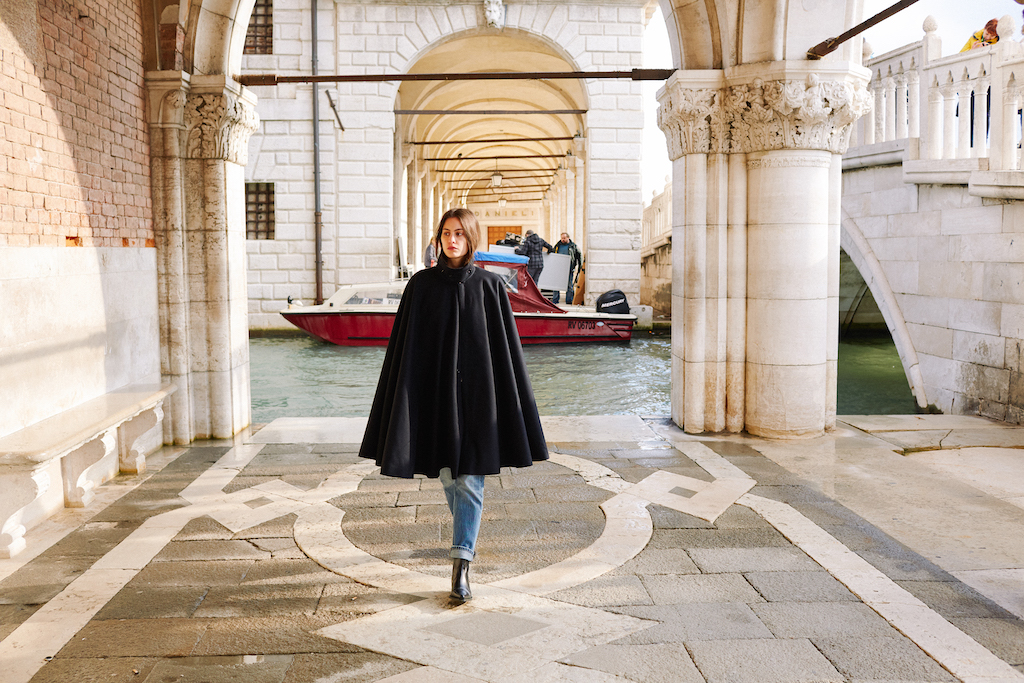
So, the cloak is also modern.
Yes, and it’s sustainable. The cloak is ecological and even recyclable. You can remake it into a blanket because of its excellent wool. I have never known anyone who has worn a cloak for only one lifetime. It’s always handed down. The world may be changing but I’m carrying on my battle because I want our work and its processes to be appreciated. I want the fabrics we use to be certified and respectful of the environment. I pay attention to the origin of the wool, whether it’s mulesing-free and I fight for South American wool, where sheep live better and are shorn by the Indians.
As for maintenance, a good brushing and, as was done in the past, ‘wash’ in the snow is enough. I wash mine with a garden hose and then leave it hanging to dry.

What is the magic behind the cloak?
The magic of the cloak is born from alchemy. The one that is created between the fabric, the thread from which the garment’s essence is released, and the hand of the creator, who gives the fabric shape and character. The tabarro also changes according to who wears it. For example, I have three cloaks: one made with the vicuña cut given to me by Mr. Loro Piana, a beautiful shiny black cloak, in case I go to Venice, and a Brigantino. The cloak expresses who we are, dresses and accompanies the life we lead and transmits an unmistakable elegance from generation to generation.
The centuries pass, but the cloak still captures our attention. Now we have to allow ourselves to be wrapped in a timeless fabric, which not only speaks of history and traditions but also of the present with a focus on sustainability.
Read More:
- Berlin's Kilim Queen: Beyza Özler from Wild Heart Free Soul
- Ca' del Bosco: Where the excellent Franciacorta wine is born
Last Updated on August 27, 2024 by Editorial Team
As editor-in-chief, Raffaele infuses the magazine with a cosmopolitan flair, drawing from his experiences in London, Berlin, New York, and Barcelona. His 20-year tenure with luxury brands, coupled with a love for travel and food, enriches the magazine's content.






